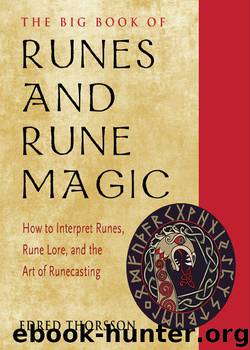The Big Book of Runes and Rune Magic by Edred Thorsson

Author:Edred Thorsson
Language: eng
Format: epub
ISBN: 9781633411098
Publisher: Red Wheel Weiser
Tyr
The essential mysteries of this god are embodied in the T-rune that is named after him. Tyr is the god of justice and of self-sacrifice for the good of society. This aspect is illustrated by the myth in which the gods capture the Fenris-Wolf by binding him with a fetter made of six things that indicate subtle mysteries, while Tyr holds his (right) hand in the jaws of the Wolf as a pledge of troth. When Fenrir finds he cannot escape, Tyr's hand is sacrificed to the jaws of the son of Loki (the Wolf). As a mythic figure, Tyr retreats into the realm of relative inactivity after this. However, in religious practice (especially that connected to legal matters) he remains a god of great importance. Tuesday is named after him. In German we have Dienstag, which is derived from an older form Dings-tag, day of the thing (legal assembly). So in one language we have the god; in the other we have the instruction over which he ruled.
As the overall structure of the psychocosmological aspects of the pantheon shows, ideally Tyr and Odin should work together in harmony as the left brain and right brain, respectively. In the process of shaping or creating anything, both forces are necessary. The Tyr aspect lays the plans, and the Odinic aspect puts the plans into action and makes them real. Tyr is the planner; Odin, the doer. The Germanic soul is essentially one of action and eternal motion. For this reason, the Odinic aspect was always at least slightly dominant in the pantheon; Odin is the high god and the All-Father. Odin's expansive transformational essence led to his aspect, largely synthesizing that of Tyr. Nowhere is this clearer than in the later legendary name of the North Star, Odin's Eye. The North Star is, of course, primarily identified with Tyr (see the T-rune), but in a sense Tyr becomes the all-seeing eye of Odin aloft on Hlidhskjálfr, the Gate-Tower. This is the eye that sees all over the worlds, whereas that which is pledged in Mímir's Well is the eye that sees “beneath” all the worlds, into their deepest secrets (runes).
The latent antagonism between Odin and Tyr is merely that which often occurs within systems composed of complementary aspects. An act of will is needed to cause them to work together harmoniously.
Download
This site does not store any files on its server. We only index and link to content provided by other sites. Please contact the content providers to delete copyright contents if any and email us, we'll remove relevant links or contents immediately.
Becoming Supernatural by Dr. Joe Dispenza(7174)
Tools of Titans by Timothy Ferriss(7031)
The Witchcraft of Salem Village by Shirley Jackson(6619)
Inner Engineering: A Yogi's Guide to Joy by Sadhguru(5957)
The Four Agreements by Don Miguel Ruiz(5592)
The Power of Now: A Guide to Spiritual Enlightenment by Eckhart Tolle(4818)
The Wisdom of Sundays by Oprah Winfrey(4661)
Room 212 by Kate Stewart(4160)
Fear by Osho(4123)
Pale Blue Dot by Carl Sagan(4068)
The David Icke Guide to the Global Conspiracy (and how to end it) by David Icke(3940)
Rising Strong by Brene Brown(3820)
Animal Frequency by Melissa Alvarez(3790)
Secrets of Antigravity Propulsion: Tesla, UFOs, and Classified Aerospace Technology by Ph.D. Paul A. Laviolette(3741)
How to Change Your Mind by Michael Pollan(3720)
Sigil Witchery by Laura Tempest Zakroff(3688)
Real Magic by Dean Radin PhD(3605)
The Art of Happiness by The Dalai Lama(3430)
Man and His Symbols by Carl Gustav Jung(3370)
